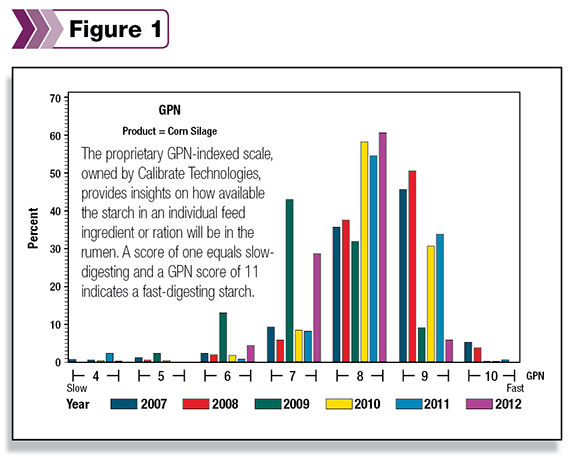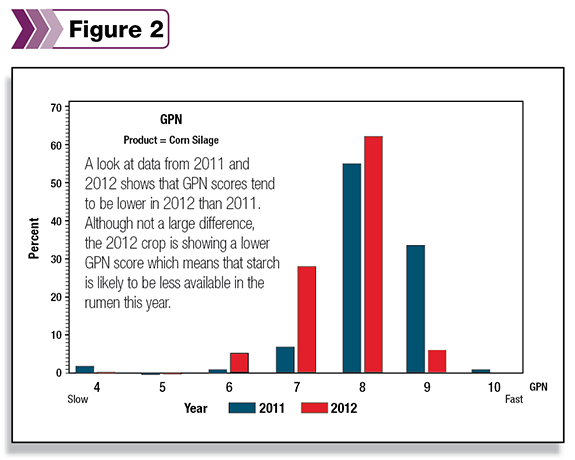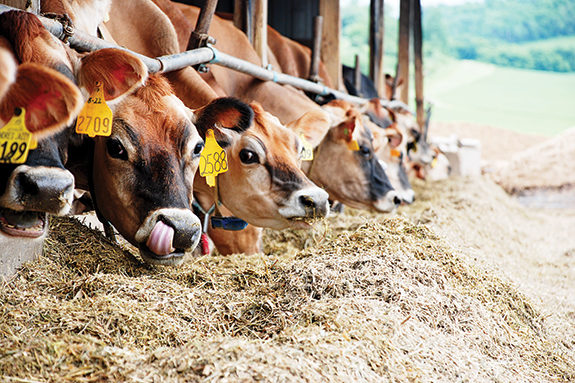The past two years have been a challenge in the dairy industry. Drought conditions have wreaked havoc on feed prices, feed availability and the quality of crops grown, not to mention the nutrient content of available forages. Like many, you may have already started feeding corn silage that was put up in 2012.
As you feed this past year’s crop, you may have noticed that while your ration has nearly the same formula as last year, it’s not performing quite the same in the cow.
Many factors could be at play, but as we learn more about starch and the availability of starch to the cow, we’re finding that starch can be the root cause of many performance changes.
There are two ways to measure starch content of the ration – crude starch and rumen-degradable starch. Crude starch measures how much starch is present in a feedstuff or ration.
Rumen-degradable starch measures how much starch is actually available to the rumen microbes when the feedstuff or ration is fed. Crude starch does not mean that all of the starch captured by this measurement is available in the rumen.
We measure rumen-degradable starch on an indexed scale of one to 11. The number provides insights on how available the starch in an individual feed ingredient or ration will be in the rumen. A score of one equals slow-digesting, and a score of 11 indicates a fast-digesting starch.

Analyzing rumen-degradable starch numbers since 2007 provides insights on just how variable starch can be ( Figure 1 ).
Variation in starch availability leads to changes in cow performance. It may be surprising to some, but starch availability can vary significantly from year to year or even field to field in the same year.
There are four measurements that we track. These are crude starch, rumen-degradable starch, NDF (neutral detergent fiber) and ruminal fiber digestibility.
If we looked purely at corn silage across the past five years, crude starch varied from 2 percent to 58 percent with an average of 30 percent.
Rumen-degradable starch scores ranged from 1 to 10.3 with an average of 7.8. NDF ranged from 28 percent to 72 percent with an average of 42 percent, and ruminal fiber digestibility ranged from 112 to 178 with an average of 147. As you can see, there is significant variability.

If we look at data from 2011 and 2012, we can make some inferences on how the 2012 crop might perform as it’s fed this year.
Rumen-degradable starch scores tended to be lower in 2012 than 2011 – not a great difference but a little lower, which means starch is likely to be less available this year ( Figure 2 ).
The animal responds to lower rumen-degradable starch numbers by producing less milk and higher components.
For example, instead of 80 pounds of milk with a 3.5 percent milk fat, a lower rumen-degradable starch may cause the animal to produce more like 75 pounds of milk with a 3.8 percent milk fat.
The impact of a low rumen- degradable starch score is similar to the anticipated “new corn silage syndrome” most farms experience when they switch from old-crop to new-crop corn silage.
Normally, we anticipate the “new corn silage syndrome” to last 30 to 60 days. This year that didn’t happen; the hangover effect of switching to the new corn silage was much longer, 60 to 90 days, meaning less starch was available to the animal for a longer period of time post-harvest.
Our laboratory tests were able to capture this “hangover” in real-time so producers could better manage their rations.
There are two ways to mitigate the “new corn silage syndrome” – leave corn silage in the bunker longer or adjust the rumen-degradable starch content of the ration to provide more available starch from other starch-containing ingredients.
Another side-effect of the 2012 crop year that will impact starch availability is poor kernel processing. At harvest, there was a lot of advanced corn kernel maturity, despite the correct harvest time. As a result, corn kernels did not process adequately, which could make starch less available to the cow.
The third factor farms should be aware of is the lingering impacts of heat stress. In areas where heat stress was severe, cows mobilized body fat reserves to meet increased maintenance requirements and protect themselves from the heat.
As a result, an animal’s energy bank account (body fat) was severely depleted. When intakes came back after the heat passed, energy was diverted into replenishing body fat reserves instead of milk.
Starch availability will affect how fast an animal refills her body fat. Good nutrition is very important in times of heat stress.
The one redeeming quality of the 2012 corn silage crop is that it is testing to have fairly good starch content, even if it isn’t as available. Instead of wasting it, one may want to consider utilizing more available sources of starch until the starch in corn silage becomes more ruminally available.
For example, if the corn silage has a crude starch level of 38 percent, but when tested came back with a low rumen-degradable starch number, some of the corn silage starch could be replaced in the diet with a feedstuff that has a higher rumen-degradable starch number.
Making ration changes with consideration of the rumen- degradable starch number can allow you to improve ration efficiency and reduce ration costs.
Evaluating rumen-degradable starch numbers can also give you insights as to where your herd is and plan ahead on how you’re going to use your feedstuffs.
Evaluating rumen-degradable starch levels through rumen- degradable starch testing is only one piece of the puzzle. When it comes to forages, you need to do all things right. PD
PHOTO
Photo courtesy of Calibrate Technologies.

David Weakley
Director - Dairy Forage Research
Calibrate Technologies
(636) 742-6178







